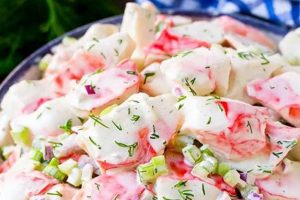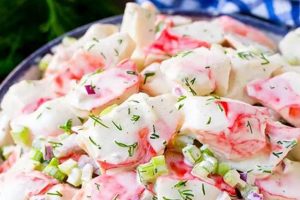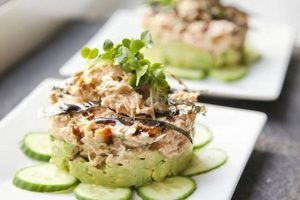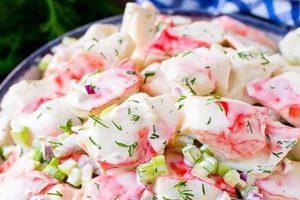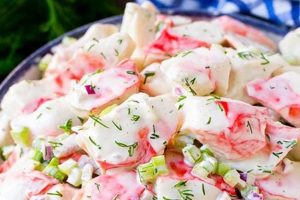A dish comprised of surimi (processed fish paste designed to mimic the flavor and texture of crab), mayonnaise, and often other ingredients such as celery, onion, and seasonings, offers a budget-friendly and convenient alternative to salads using genuine crab. Variations exist, incorporating diverse additions like hard-boiled eggs, bell peppers, or different herbs and spices. A simple preparation often involves combining all elements in a bowl and chilling before serving.
This type of salad provides a lighter, refreshing option suitable for picnics, potlucks, or quick lunches. Its accessibility and adaptability contribute to its widespread popularity. Historically, surimi has roots in East Asian cuisine, where techniques for processing fish into various forms have been practiced for centuries. Its adaptation into a crab-like product and subsequent integration into Western cuisine have made it a readily available ingredient. This accessibility democratizes a dish reminiscent of more expensive seafood salads.
Further exploration of this culinary creation will encompass specific ingredient selections, detailed preparation methods, nutritional information, and potential variations to cater to diverse tastes and dietary needs.
Tips for Crafting an Excellent Surimi Salad
Optimizing the flavor and texture of a surimi salad involves careful consideration of ingredients and preparation techniques. The following tips offer guidance for creating a superior dish.
Tip 1: Quality Surimi Selection: Opt for high-quality surimi that exhibits a firm texture and a delicate, slightly sweet flavor. Avoid products with an overly fishy odor or a mushy consistency.
Tip 2: Mayonnaise Matters: The mayonnaise serves as the foundation of the salad’s flavor profile. Experiment with different types, such as Japanese mayonnaise or flavored varieties, to achieve desired nuances. Consider using a combination of mayonnaise and plain yogurt or sour cream for a lighter, tangier result.
Tip 3: Enhancing Texture: Finely diced celery and red onion provide a satisfying crunch and enhance the overall textural experience. Other vegetables like finely chopped bell peppers or water chestnuts can also contribute textural variety.
Tip 4: Seasoning Strategically: Old Bay seasoning, dill, paprika, or a touch of lemon zest can elevate the flavor profile. A small amount of Dijon mustard can add a subtle tanginess.
Tip 5: Chilling for Optimal Flavor: Allowing the salad to chill for at least 30 minutes in the refrigerator allows the flavors to meld and the salad to firm up, enhancing both taste and presentation.
Tip 6: Presentation Considerations: Serve the salad on a bed of lettuce, in scooped-out avocados, or as a filling for sandwiches or wraps. Garnish with fresh herbs like parsley or dill for visual appeal.
Tip 7: Avoiding Overmixing: Gently fold the ingredients together to avoid breaking down the surimi and creating a mushy texture. Maintaining distinct pieces contributes to a more pleasing mouthfeel.
By adhering to these suggestions, one can elevate a simple surimi salad into a truly delightful culinary experience. Attention to detail in ingredient selection, flavor balancing, and presentation results in a dish that is both satisfying and aesthetically pleasing.
The following section will explore various recipe adaptations and serving suggestions for incorporating surimi salad into a diverse range of meals and occasions.
1. Ingredients
Ingredient selection significantly impacts the final quality, flavor profile, and overall success of an imitation crab meat salad recipe. The interplay between individual components contributes to the dish’s character, ranging from a light and refreshing salad to a richer, more savory experience. Careful consideration of each ingredient’s properties and its interaction with others is essential. For instance, the type of mayonnaise used, whether classic, Japanese-style, or a lighter version, directly influences the salad’s creaminess and overall taste. Similarly, the choice of vegetables, such as crisp celery, pungent red onion, or sweet bell pepper, introduces varying textures and flavor dimensions. Even seemingly minor ingredients, like the type of seasoning or a squeeze of lemon juice, can significantly alter the final product.
Specific examples illustrate this impact. Using a lower-quality surimi with a higher starch content can result in a mushy texture, while premium surimi offers a firmer, more desirable consistency. Freshly chopped herbs, compared to dried, provide a brighter, more vibrant flavor. The balance of ingredients is also crucial. Too much mayonnaise can overwhelm the other flavors, while too little can result in a dry, less palatable salad. The quantity and type of seasonings also require careful calibration to achieve the desired taste profile, whether aiming for a classic, spicy, or tangy rendition. Understanding these nuances allows for informed ingredient choices tailored to specific preferences and desired outcomes.
Mastery of ingredient selection empowers one to create a superior imitation crab meat salad. This understanding extends beyond simply following a recipe; it fosters culinary creativity and the ability to adapt the dish to individual tastes and dietary needs. Challenges such as achieving optimal texture and flavor balance can be addressed through thoughtful ingredient choices and careful preparation techniques. This ingredient-focused approach ultimately elevates the dish from a simple combination of components to a carefully crafted culinary creation.
2. Preparation
Preparation methods significantly influence the final quality and palatability of an imitation crab meat salad. The manner in which ingredients are handled, combined, and chilled directly impacts texture, flavor development, and overall presentation. Consider the effect of chopping vegetables: coarsely chopped pieces create a chunky, rustic salad, while finely diced ingredients yield a smoother, more delicate texture. Similarly, the way surimi is handled matters. Overmixing can lead to a shredded, less appealing consistency, whereas gentle folding preserves the integrity of the pieces. Chilling time also plays a crucial role. Insufficient chilling prevents flavors from melding, while excessive chilling can negatively affect the texture of certain ingredients. Cause and effect relationships are evident throughout the preparation process; each action taken directly impacts the final outcome.
Several practical examples illustrate the importance of proper preparation. For instance, if celery is chopped too thickly, it can overpower the other ingredients, creating an imbalance in texture and flavor. Conversely, if the surimi is broken down excessively during mixing, the salad becomes mushy and less visually appealing. Consider the impact of neglecting to chill the salad adequately. The flavors remain distinct and undeveloped, resulting in a less satisfying culinary experience. These examples demonstrate the practical significance of understanding preparation techniques. Mastery of these techniques allows one to control the final product, ensuring a desirable outcome in terms of texture, flavor, and presentation.
Precise and methodical preparation techniques are integral to a successful imitation crab meat salad recipe. Attention to detail in each step, from ingredient handling to chilling time, ensures a harmonious blend of flavors and textures. Challenges, such as achieving optimal consistency and flavor development, are addressed through careful execution of preparation methods. This understanding empowers one to create a dish that is not only visually appealing but also delivers a delightful culinary experience. A properly prepared salad showcases the potential of even simple ingredients, transforming them into a cohesive and satisfying culinary creation.
3. Variations
The inherent adaptability of imitation crab meat salad recipes allows for extensive variation, transforming a basic concept into a diverse range of culinary expressions. This adaptability stems from the salad’s simple core ingredients, which serve as a blank canvas for culinary creativity. Variations can range from subtle flavor adjustments to significant ingredient substitutions, catering to a wide spectrum of preferences and dietary needs. The ability to modify the recipe based on available ingredients, desired flavor profiles, or specific dietary restrictions underscores the practical significance of understanding these variations. Cause and effect relationships are evident: each alteration to the recipe, whether adding a spice, substituting an ingredient, or adjusting quantities, directly impacts the final flavor and textural profile of the salad. For instance, incorporating diced jalapeos introduces a spicy kick, while adding grapes and pecans creates a sweeter, more textured salad. Substituting Greek yogurt for a portion of the mayonnaise yields a lighter, tangier result. These modifications exemplify the direct link between variation and outcome.
Real-world examples further highlight the versatility of this dish. Consider a classic picnic scenario: a traditional imitation crab salad provides a refreshing and convenient option. However, for a more sophisticated gathering, the recipe can be elevated by incorporating avocado, fresh dill, and a squeeze of lemon. For those seeking a lower-calorie option, substituting Greek yogurt and reducing the amount of mayonnaise creates a lighter version without sacrificing flavor. In a context where dietary restrictions are a concern, the adaptability of the recipe shines. Gluten-free variations are readily achievable by ensuring all ingredients, especially seasonings and additions, are gluten-free. Vegetarian versions can be crafted by substituting imitation crab meat with hearts of palm or artichoke hearts, maintaining a similar textural experience. These adaptations demonstrate the practical implications of understanding variations, enabling the dish to be tailored to a variety of contexts and needs.
Mastery of variations elevates imitation crab meat salad beyond a simple recipe, transforming it into a versatile culinary tool. This understanding empowers one to create custom flavor profiles, accommodate dietary restrictions, and adapt the dish to various occasions. Challenges, such as balancing flavors when introducing new ingredients or maintaining desirable texture when substituting components, are addressed through careful consideration of each variation’s impact. Ultimately, embracing the potential for variation unlocks the full culinary potential of this adaptable and satisfying dish.
4. Serving Suggestions
Serving suggestions provide context and inspiration for integrating imitation crab meat salad into various culinary applications. These suggestions extend beyond simply presenting the salad; they highlight its versatility and potential to complement other dishes or serve as a standalone meal component. Understanding these options broadens the culinary repertoire and allows for creative meal planning.
- Standalone Light Meal:
Served on a bed of lettuce, garnished with fresh herbs, and accompanied by crackers or crusty bread, the salad functions as a complete and satisfying light meal. This approach emphasizes the salad’s refreshing qualities, making it ideal for lunches, picnics, or light dinners.
- Sandwich or Wrap Filling:
The salad’s texture and flavor profile make it an excellent filling for sandwiches, wraps, or even pita pockets. Combining it with crisp lettuce, tomato, and other desired fillings elevates a simple sandwich into a flavorful and texturally satisfying meal.
- Appetizer on Crackers or Cucumber Slices:
For gatherings or appetizers, small portions of the salad served on crackers, cucumber slices, or endive leaves offer a convenient and elegant presentation. This serving style highlights the salad’s delicate flavors and allows for portion control.
- Complement to Seafood Dishes:
As a side dish to grilled or baked fish, the salad’s subtle crab-like flavor complements the main course without overpowering it. This pairing offers a harmonious balance of flavors and textures, enhancing the overall dining experience.
These serving suggestions illustrate the versatility of imitation crab meat salad. Whether served as a standalone dish, a sandwich filling, an appetizer, or a complement to other seafood, its adaptable nature allows for seamless integration into a variety of culinary contexts. Understanding these options empowers one to utilize this salad creatively, maximizing its potential and enhancing meal planning flexibility.
5. Nutritional Information
Nutritional information provides crucial context for incorporating imitation crab meat salad into a balanced diet. Understanding the nutritional composition of this dish allows for informed choices regarding portion sizes, ingredient modifications, and frequency of consumption. This information is particularly relevant for individuals monitoring specific dietary components, such as calories, protein, fat, or sodium intake.
- Calorie Content
Calorie content varies depending on the specific recipe and ingredient proportions. Generally, imitation crab meat salad is moderately caloric, primarily due to the mayonnaise content. Using lower-fat mayonnaise or incorporating more vegetables can reduce the overall calorie density. Understanding caloric content allows for appropriate portioning and integration into a balanced meal plan.
- Macronutrient Profile
The macronutrient profile, encompassing protein, carbohydrates, and fats, provides insight into the salad’s nutritional composition. While imitation crab meat itself offers a source of protein, the overall protein content is often moderate. Carbohydrates are typically low, primarily derived from added vegetables. Fat content can be significant, largely originating from the mayonnaise. Analyzing the macronutrient profile helps individuals align the dish with their specific dietary goals.
- Sodium Content
Sodium content can be a concern in imitation crab meat salad due to the processed nature of surimi and the addition of seasonings. Monitoring sodium intake is particularly important for individuals with hypertension or other sodium-sensitive conditions. Opting for lower-sodium ingredients or adjusting seasoning quantities can mitigate this concern.
- Micronutrient Contribution
While not a significant source of micronutrients, the inclusion of vegetables in the salad contributes to overall micronutrient intake. Adding ingredients like bell peppers, celery, and onions introduces vitamins and minerals, enhancing the nutritional value of the dish. Strategic ingredient selection can maximize micronutrient density.
Careful consideration of nutritional information empowers individuals to integrate imitation crab meat salad into a balanced diet effectively. Understanding caloric content, macronutrient profile, sodium content, and potential micronutrient contributions allows for informed choices regarding ingredient selection, portion sizes, and frequency of consumption. This awareness facilitates informed dietary decisions aligned with individual health goals and preferences.
6. Storage
Proper storage is crucial for maintaining the quality, safety, and palatability of imitation crab meat salad. This aspect, often overlooked, directly impacts the dish’s longevity and ability to retain desirable characteristics. Cause and effect relationships are central to understanding the importance of storage. Improper storage practices, such as leaving the salad at room temperature for extended periods, can lead to bacterial growth and spoilage, posing health risks and compromising flavor. Conversely, appropriate refrigeration effectively inhibits bacterial proliferation, preserving the salad’s freshness and extending its shelf life. This understanding underscores the practical significance of correct storage procedures.
Real-world examples illustrate the impact of storage practices. Consider a scenario where the salad is left unrefrigerated after a picnic. Exposure to warm temperatures creates an environment conducive to rapid bacterial growth, rendering the salad unsafe for consumption. Conversely, if the salad is promptly refrigerated in an airtight container, its shelf life extends considerably, allowing for enjoyment over several days. These contrasting outcomes highlight the direct link between storage practices and the preservation of food quality and safety.
Effective storage hinges on several key practices. Airtight containers prevent oxidation and minimize exposure to airborne contaminants. Consistent refrigeration at appropriate temperatures inhibits bacterial growth and preserves freshness. Adhering to recommended storage durations further safeguards against spoilage. Challenges, such as maintaining consistent refrigeration during transport or preventing cross-contamination in storage containers, underscore the practical considerations associated with effective storage. Addressing these challenges ensures optimal preservation and minimizes potential health risks.
7. Flavor Profiles
Flavor profiles constitute a crucial dimension of imitation crab meat salad recipes, significantly influencing overall palatability and enjoyment. Understanding how individual ingredients contribute to the overall flavor profile empowers culinary customization and ensures a satisfying sensory experience. The interplay of core ingredients, such as surimi, mayonnaise, and seasonings, forms the foundation of the flavor profile. Variations in these ingredients, along with the addition of complementary components, allow for a spectrum of flavor possibilities, ranging from classic to innovative.
- Classic & Traditional:
This profile emphasizes the delicate, slightly sweet flavor of surimi, complemented by the creamy richness of mayonnaise. Traditional seasonings like celery seed, Old Bay, or dill contribute subtle savory notes, resulting in a familiar and comforting taste. This classic profile often resonates with those seeking a familiar and predictable flavor experience.
- Zesty & Bright:
A zesty and bright profile incorporates ingredients that add tanginess and freshness. Lemon juice, Dijon mustard, or chopped fresh herbs like dill and parsley contribute vibrant acidity, balancing the richness of the mayonnaise. This profile appeals to those who prefer lighter, more refreshing flavors.
- Spicy & Bold:
Spicy and bold profiles incorporate elements that introduce heat and complexity. Diced jalapeos, sriracha, or a dash of cayenne pepper add a fiery kick, while ingredients like smoked paprika or chipotle powder contribute smoky undertones. This profile caters to those who enjoy bolder, more intense flavor experiences.
- Sweet & Savory:
Sweet and savory profiles balance contrasting flavors to create a more complex and nuanced taste. The incorporation of ingredients like chopped grapes, dried cranberries, or toasted pecans introduces sweetness, while savory elements like crumbled bacon or toasted sesame seeds provide a counterpoint. This profile offers a balanced and intriguing flavor combination.
The exploration of these flavor profiles demonstrates the versatility of imitation crab meat salad. Understanding how individual ingredients and their combinations contribute to specific flavor profiles empowers one to tailor the recipe to individual preferences. This knowledge transforms a simple dish into a customizable culinary canvas, allowing for endless flavor exploration and adaptation.
Frequently Asked Questions
This section addresses common inquiries regarding imitation crab meat salad recipes, providing concise and informative responses to clarify potential uncertainties and enhance understanding.
Question 1: What is imitation crab meat made of?
Imitation crab meat, also known as surimi, is primarily composed of processed white fish, typically pollock. Starches, fillers, flavorings, and colorings are added to mimic the texture and taste of real crab.
Question 2: Is imitation crab meat healthy?
While a source of protein, imitation crab meat is often processed and can be high in sodium. Nutritional value varies depending on the brand and specific ingredients. Moderation is key when incorporating it into a balanced diet.
Question 3: How long can imitation crab meat salad be stored in the refrigerator?
Properly stored in an airtight container, imitation crab meat salad typically lasts for 3-5 days in the refrigerator. Spoilage signs include a sour odor, discoloration, or a slimy texture.
Question 4: Can imitation crab meat salad be frozen?
Freezing is generally not recommended, as it can negatively impact the texture of the salad, resulting in a watery consistency upon thawing. The mayonnaise base also tends to separate when frozen.
Question 5: What are some common allergens in imitation crab meat salad?
Common allergens include fish, shellfish (due to cross-contamination potential during processing), soy, wheat, and gluten (depending on added ingredients like soy sauce or imitation crab seasonings). Always check ingredient labels carefully.
Question 6: How can one reduce the sodium content in imitation crab meat salad?
Using lower-sodium mayonnaise, rinsing the surimi before use, and minimizing added salt or salty seasonings can effectively reduce overall sodium content. Opting for fresh herbs and spices instead of pre-made seasoning blends also helps.
Careful consideration of these frequently asked questions ensures informed preparation and consumption of imitation crab meat salad. This knowledge promotes safe handling, appropriate storage, and informed dietary choices.
The subsequent section will offer a curated selection of imitation crab meat salad recipes, ranging from classic preparations to innovative variations.
Imitation Crab Meat Salad Recipe
Exploration of imitation crab meat salad recipes reveals a dish characterized by versatility, affordability, and adaptability. From ingredient selection and preparation techniques to nutritional considerations and flavor profile variations, the multifaceted nature of this culinary creation offers a range of possibilities for both novice and experienced cooks. Key aspects highlighted include the importance of quality surimi selection, the impact of mayonnaise choices on flavor and texture, the role of complementary ingredients in enhancing the overall sensory experience, and the significance of proper storage for maintaining quality and safety. The adaptability of this recipe allows for customization based on individual preferences, dietary needs, and available resources, making it a practical and accessible culinary option.
Ultimately, an understanding of the core principles underlying imitation crab meat salad recipes empowers culinary exploration and informed decision-making. This knowledge fosters creativity in the kitchen, allowing for personalized adaptations and innovative flavor combinations. Further investigation into specific regional variations, cultural adaptations, and the evolving landscape of surimi production promises to deepen appreciation for this versatile and widely enjoyed dish.

